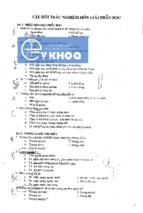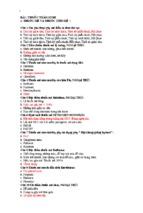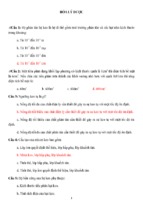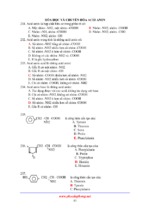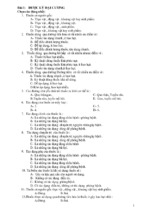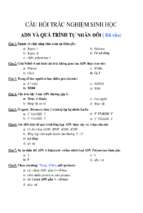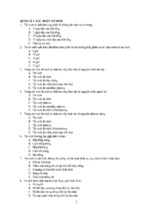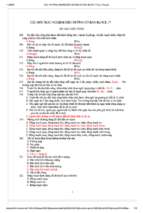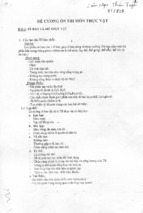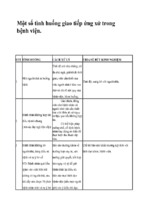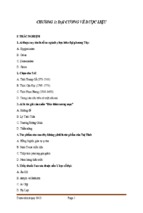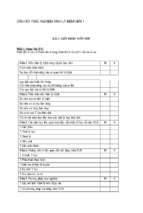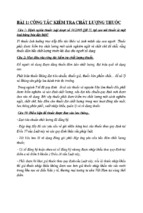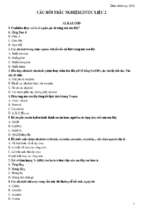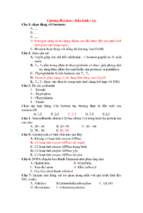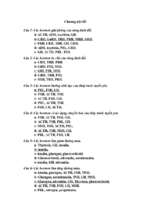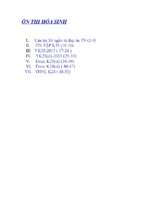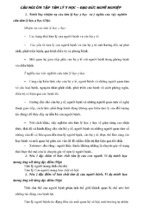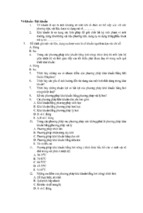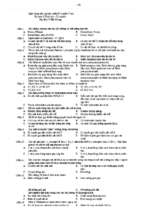MEDICAL ENGLISH
THAN LAN CON ENGLISH CENTER
This learning material is made by Hoang Bao Long, MD
and is a property of Than Lan Con English Center.
Contents
Language Points.................................................................................................................. 4
Skills .................................................................................................................................. 6
Introduction ........................................................................................................................ 7
Chapter 1: Medical Terminology........................................................................................ 11
Chapter 2: Hospitals And Medical Schools ......................................................................... 15
Chapter 3: History Taking.................................................................................................. 22
Chapter 4: Anatomy .......................................................................................................... 35
Chapter 5: The Systems ..................................................................................................... 45
Chapter 6: Physical Examination........................................................................................ 50
Chapter 7: Cardiovascular Diseases.................................................................................... 53
Chapter 8: Investigations ................................................................................................... 61
Chapter 9: Respiratory Diseases ......................................................................................... 70
Chapter 10: Diagnosis ....................................................................................................... 77
Chapter 11: Abdomen and Pelvis ....................................................................................... 84
Chapter 12: Other Conditions............................................................................................. 89
Chapter 13: Management ................................................................................................... 97
Chapter 14: Medical Research...........................................................................................112
Appendix 1: Presentation ..................................................................................................121
Language Points
Û
Point 1: Latin-based medical terms ............................................................................... 11
Û
Point 2: Vocabulary – Some first Latin roots ................................................................. 12
Û
Point 3: Hospitals ........................................................................................................ 15
Û
Point 4: Vocabulary – Terms about hospitals ................................................................. 17
Û
Point 5: Medical schools .............................................................................................. 19
Û
Point 6: Topics of questions.......................................................................................... 22
Û
Point 7: Some common terms of past history ................................................................. 24
Û
Point 8: Summarizing symptoms................................................................................... 27
Û
Point 9: Vocabulary - Symptoms .................................................................................. 28
Û
Point 10: Divisions of Anatomy .................................................................................... 35
Û
Point 11: Vocabulary – Common anatomical terms ........................................................ 38
Û
Point 12: Describing anatomical details ......................................................................... 41
Û
Point 13: Physical examination ..................................................................................... 50
Û
Point 14: Writing description of signs ........................................................................... 51
Û
Point 15: Valvular heart diseases .................................................................................. 53
Û
Point 16: Thromboembolism ........................................................................................ 54
Û
Point 17: Vocabulary – Thromboembolism.................................................................... 56
Û
Point 18: Cardiovascular examination ........................................................................... 56
Û
Point 19: Describing heart sounds ................................................................................. 58
Û
Point 20: Types of investigations .................................................................................. 61
Û
Point 21: Vocabulary – Some more Latin roots .............................................................. 65
Û
Point 22: Describing and interpreting laboratory findings ............................................... 67
Û
Point 23: Vocabulary – Some more Latin roots .............................................................. 68
Û
Point 24: Vocabulary – Some more Latin roots .............................................................. 76
Û
Point 25: Types of diagnosis ......................................................................................... 77
Û
Point 26: Vocabulary – Diagnosis ................................................................................. 77
Û
Point 27: Explaining your diagnostic approach .............................................................. 77
Û
Point 28: Diagnostic criteria ......................................................................................... 81
Û
Point 29: Vocabulary – Some more Latin roots .............................................................. 87
Û
Point 30: Nervous system ............................................................................................. 89
Û
Point 31: Infectious diseases ......................................................................................... 92
Û
Point 32: Kidney diseases ............................................................................................. 94
Û
Point 33: Vocabulary – Emergency medicine ................................................................. 95
Û
Point 34: Drug information......................................................................................... 100
Û
Point 35: Writing a prescription .................................................................................. 104
Û
Point 36: Vocabulary – Monitoring and prognosis ........................................................107
Û
Point 37: Vocabulary – Management ...........................................................................108
Û
Point 38: What is research? .........................................................................................112
Û
Point 39: Common biostatistic terms ...........................................................................115
Û
Point 40: Expressing numbers, proportions and percentages ..........................................117
Skills
` Skill 1: Looking up the terms ....................................................................................... 14
` Skill 2: Different word classes of a word....................................................................... 18
` Skill 3: Types of questions ........................................................................................... 22
` Skill 4: Searching for terms in a topic ........................................................................... 24
` Skill 5: Writing English ............................................................................................... 29
` Skill 6: Review of noun modifiers ................................................................................ 31
` Skill 7: Skimming ....................................................................................................... 37
` Skill 8: Reading flowcharts .......................................................................................... 65
` Skill 9: Reading tables and charts ............................................................................... 118
Introduction
Welcome to Than Lan Con English Center. You are looking at the learning document specifically
designed for students studying medical English at TLC. Please read this chapter very carefully.
(I) This is not a reference book; hence, we do not cover everything about medical English in this
document (and actually we do not wish to do so). What we are doing is trying to provide you a
solid foundation to base your continuity of learning on. Thus, a learner who wishes to learn
everything about medical English shall never feel satisfied with the course (and once again, we
do not wish you to do so). Medical English is extremely broad since it is composed of jargons
from all the fields of science, and learning every term over a short course is impossible and
insensible. At TLC, we help you start with some basic knowledge, serving as a good example for
self-study, then, over time, you will maintain your own research into medical English.
(II) The most appropriate people to participate in this medical English course are general doctors
and medical students who have an acceptable level of general English (equivalent to B1 or IELTS
5.0) and want to learn medical English for daily use (e.g., to read medical literature in English,
to discuss with English-speaking colleagues, or to write medical notes in English). If your level
is inferior to this requirement, we strongly recommend you to start your learning with a basic
course of general English. If your purpose is other than daily use, for instance, to pass the
examination in the medical schools, we suggest you to find another course. And since we focus
on English for clinical medicine, people working in dentistry, pharmacy, nursing and other
specialties less related to clinical practice might not sufficiently benefit from the course.
(III) Our course is designed:
1. To provide learners with basic English medical terms and expressions that are required
for clinical practice in the Vietnamese hospital settings;
2. To facilitate learners to use learning tools to study medical English (i.e., preparing and
delivering presentations, looking up in the Internet and medical textbooks, and
teamwork);
3. To introduce self-study methods and encourage learners to continue self-study after
finishing the course.
The document, therefore, will reflect our three educational goals. You will be provided with (1)
fundamental context-based vocabulary and structures, (2) brief instructions on relevant skills,
and (3) exercises to guide you on self-study. Since this document has a supportive nature, it
cannot replace the actual learning with lecturers at TLC. We have, of course, tried to make it as
ready as possible for you so that even if you miss a learning session, you will still be able to
review the document and learn from it.
In this course, medical English is developed within the framework of clinical medicine. Therefore,
we will take you through all the fundamental and clinical subjects. This is not necessarily a review
of clinical medicine, but you will feel that learning medical English is easier and more profound
if you have already possessed a certain amount of clinical knowledge.
(IV) There are two main sections in this document: 14 learning chapters where you find new
knowledge points, exercises and skill introduction, and 01 appendices where additional but
helpful topics are discussed. Learning sessions at TLC might not fully cover all the knowledge
points mentioned in the document; however, learners are encouraged to study the remaining
knowledge points as a practical exercise for self-study.
(V) We divide each chapter into several sections, and you will realize them by the symbols:
Symbol
Section
Description
Û
Knowledge points
We provide knowledge points in a variety of formats – most of
them will be in a context. Context-based learning has been
proved to facilitate the memorization of knowledge.
We also provide you a small group of most commonly used
medical terms and expression, with some fundamental
language points at the beginning and, over time, more
extensive sets of medical terms. This will help you get
acquainted with the breadth and depth of medical English.
J
Exercises
You will practice the use of knowledge points with a set of
dynamic exercises. They do not only help you repeat the
knowledge points you have learned, but also guide you on selfstudy. We do not provide keys for the exercise (and usually,
due to the nature of the exercises, keys are not required).
There are two types of exercises: individual tasks and group
tasks (marked with INDIVIDUAL or GROUP at the beginning
of the exercises’ description). For individual tasks, you can do
them yourselves and even before going to the class. For group
tasks, it is recommended to work in groups for the information
exchange and collaboration can promote better understanding
of the language points.
`
Skill introduction
To serve the third educational goal, we dedicate a separate
section guiding you on several skills. They will support you on
your self-study activities after you have finished the learning
course with TLC.
(VI) Learning terminology
Medical terminology is the utmost part of importance in learning medical English, but also the
biggest challenge for learners. It is nevertheless not insurmountable if you understand the learning
method. Please keep in mind the following points:
1. Many medical terms are the combination of Latin roots, prefixes and suffixes. Instead of
learning individual words, you are therefore recommended to spend time on learning
these Latin elements and how to combine them. Again, context-based learning helps
reduce the boring quality as well as the time spent on this study.
2. Many Latin roots are the equivalent words for body parts. You will need to take a short
course over gross anatomy to memorize all the important body structures (both the
common English terms and academic Latin roots) before continue to learn terms related
to symptoms, signs and diseases.
3. What are covered in this document?
- Basic anatomical terms, and names and Latin roots of important body structures.
- Symptoms and signs, and relevant terms about history taking and physical examination.
- Names of common diseases.
- Some common investigations.
- Basic terms regarding patient management.
The following topics are covered: cardiovascular system, respiratory system, gastrointestinal system, urinary system, nervous system and infectious diseases.
(VII) You might wonder why the document is purely in English. We do have several reasons:
1. The easiest way to understand English is to use it. Circumventing your learning by taking
all the words through Vietnamese will slow down your progress, and more importantly,
prevent you from feeling the language’s common sense which is essential for a reflexive,
natural and fluent English. We want you to memorize in English, think in English and
respond to English in English.
2. Many medical terms are not the same in Vietnamese. For example, sepsis is not “nhiễm
khuẩn huyết” (possibly roughly translated as bacteremia) as many doctors usually call it.
Sepsis is an infection (caused by any pathogen infected in any organ) resulting in the
systemic inflammatory response syndrome (SIRS). Both the word “nhiễm khuẩn huyết”
and its definition currently used in the Vietnamese contexts do not correctly reflect the
definition of sepsis.
3. Learning medical English in this way requires you to refer to English textbooks. There
is a discrepancy between the clinical knowledge in Vietnam and in other countries. We
encourage you to explore the clinical knowledge in English textbooks because we
personally feel that this knowledge is more systematic, structural, clear, concise, precise
and practical. It firstly solidifies your medical knowledge, then provides you a common
language to interact with international experts.
Changing your mindset in learning foreign languages might be difficult at first, but over time,
your reflex will quickly grow. As soon as you have get acquainted with handling an English
document without support from Vietnamese, you will memorize the language points faster, more
easily and for a longer term.
Finally, we wish you good luck. Please use the document wisely!
TLC ENGLIS H CENTER | Medical English | Learning Document V1.0
Chapter 1: Medical Terminology
J
EXERCISE 1
(INDIVIDUAL) Look at the following terms and underline the part that you think to be in
common.
1
hematology, hemolysis, hematemesis, hemoptysis, hemopneumothorax
2
cardiovascular, endocarditis, cardiac arrest, cardiectomy, cardiopulmonary resuscitation
3
urinalysis, urolithotomy, pyuria, dysuria, urology
4
cystectomy, nephrectomy, gastrectomy, hepatectomy, thyroidectomy
5
anaphylaxis, anemia, apnea, asystole, anuria
J
EXERCISE 2
(INDIVIDUAL) Match each word in the left column with ONE word in the right column that
you think to be the most relevant.
1
post-surgical complication
glomerulus
A
2
Dengue hemorrhagic fever
hemorrhage
B
3
pansystolic murmur
interstitium
C
4
glomerulonephritis
systole
D
5
interstitial lung disease
digestive surgery
E
Û
POINT 1: LATIN-BASED MEDICAL TERMS
A large portion of medical terms shares the Latin and Greek origin. You can understand a term
by breaking it into word parts and combining their meaning.
There are three major components of a term: roots (some can stand alone but most are combined
with prefixes and/or suffixes), prefixes (they stand before the roots and can never stand alone),
and suffixes (they stand after the roots and can never stand alone). Roots themselves have
meanings, but prefixes and suffixes modify the roots by adding further meaning to them.
ENDO/CARD/ITIS
endo- = “inside”
cardio- = “heart”
-itis = “inflammation”
Prefix
Root
Suffix
= an inflammation inside of the heart
(the inner layer of the heart is called “endocardium”)
11
TLC ENGLIS H CENTER | Medical English | Learning Document V1.0
J
EXERCISE 3
(INDIVIDUAL) You now will see a chart presenting the annual income of doctors in different
specialties1 . Look at the terms in the chart and use any tools to understand the meaning of
these specialties. Try to explain the meaning of the roots.
Many names of the specialties end with -logy. This suffix means “the study of”; for example,
cardiology can roughly be translated into “the study of the heart”. A cardiologist is a scientist
who studies about the heart (and its diseases); so, the -logist suffix implies a specialist.
Û
POINT 2: VOCABULARY – SOME FIRST LATIN ROOTS
Root
Explanation
cardiodermato-/dermo-
skin
entero-
intestine
gastro-
stomach
hemo-/hemato-
blood
immuno-
immune system
myo-/myos-
muscle
nephro1
heart
kidney
http://www.medscape.com/features/slideshow/compensation/2015/public/overview/
12
TLC ENGLIS H CENTER | Medical English | Learning Document V1.0
neuro-
nerve
onco-
tumor
ophthalmo-
eye
patho-
disease
uro-
urine
-itis
inflammation
-logist
a person who studies about
-logy
the study of
endo-
inside
peri-
surrounding
J
EXERCISE 4
(INDIVIDUAL) What do the following terms mean?
Latin term
1
pericarditis
2
endophthalmitis
3
pathologist
4
nephritis
5
Explanation
gastritis
6
inflammation of the stomach and the intestine
7
a doctor who studies about tumors
8
inflammation of the nerve
9
a doctor who studies about the urinary system
10
inflammation of the skin and muscle
13
TLC ENGLIS H CENTER | Medical English | Learning Document V1.0
`
SKILL 1: LOOKING UP THE TERMS
When you meet a new term and you cannot guess its meaning (because you do not know the
roots, for instance), it is best to look it up in English. Do not try to ask anyone for its definition
in Vietnamese, because the two terms in English and Vietnamese might not be equivalent.
There are several ways to look up the words:
1. Googling the term: Just type the
term in Google. Most simple terms
will give you a simple explanation
in the several first results. See the
image below for the search results
of cardiologist. Even if you cannot
understand the whole sentence,
you can still guess the meaning of
the term by looking for keywords;
in this example, “doctors” and
“heart and blood vessels” suggest
that a cardiologist is simply called
a “heart doctor”.
2. Looking for the meaning of the roots:
Try to look up cardiologist on
http://en.wiktionary.com. In addition to
the explanation of the term, you can refer
to the Etymology section for the
structure of the term and click on each
word part for further explanation.
14
TLC ENGLIS H CENTER | Medical English | Learning Document V1.0
Chapter 2: Hospitals And Medical Schools
Û
POINT 3: HOSPITALS
Types of hospitals
The hospitals in Vietnam manage patients within a district, a province, a region or the entire
nation;
hence, there are district hospitals, provincial/town hospitals, and
regional/central/national hospitals. Most of the hospitals are general hospitals, which mean they
manage patients with all sorts of medical conditions. There are some hospitals specialized in only
one group of diseases, for instance, surgical conditions; they are called specialist hospitals.
The story of Mr. Chung
Mr. Chung, a 40-year-old officer, had been experiencing high fever for several days. He had
thought it was just some viral fever until he started to feel short of breath. He was taken to the
emergency room (ER) in a provincial hospital. A junior doctor did the initial evaluation with
history taking and physical examination. On measuring vital signs, he had high fever, pulse rate
and blood pressure were within normal ranges, his breathing was fast, and the oxygen saturation
was low. These abnormal breathing signs indicated respiratory failure, an emergency condition.
She requested the team to initiate the management for Mr. Chung with oxygen therapy. However,
his condition appeared not to improve. Because the hospital did not have ventilators, the ER
doctor decided to transfer the patient to a specialist hospital. She wrote a referral letter,
mentioning the provisional diagnosis of pneumonia.
At the specialist hospital, Mr. Chung was admitted to the intensive care unit (ICU). The
definitive/final diagnosis of pneumonia was made after a bedside chest X-ray was ordered.
Further investigations also revealed anemia which required some more testing for differential
diagnosis. He was put on ventilation and treated with antibiotics. Blood tests were done every
day to monitor his inflammatory response and anemia. He was lucky that no other interventions,
such as arterial line, were required. After two weeks staying in the ICU, Mr. Chung had recovered
very well. He was then transferred to the Respiratory Department to continue treatment. Two
weeks later, he was discharged home with some prescription medications and the ward doctor
required him to return to the outpatient clinic (OPC) after one month for follow-up.
J
EXERCISE 5
(INDIVIDUAL) Tick “X” in the appropriate types for the following hospitals.
District
hospital
Provincial/town
hospital
Central/national
hospital
General
hospital
Specialist
hospital
Bach Mai Hospital
National Hospital for
Tropical Diseases
Vietnam National
Children’s Hospital
Viet Duc University
Hospital
Ba Vi Hospital
Hung Yen Hospital
15
TLC ENGLIS H CENTER | Medical English | Learning Document V1.0
J
EXERCISE 6
(INDIVIDUAL) Fill in the blanks with appropriate words (refer to the Reading section).
1. Words to describe “a place receiving and treating patients”:
room
2. Blood pressure, pulse rate, respiratory rate, and temperature are called _______________.
3. When you have a new patient, you need to _______________ him/her. This includes
______________________________ and ______________________________.
4. You
find
that
a
patient
has
respiratory
failure.
It
is
considered
an
______________________________ and he needs immediate _______________.
5. There are three kinds of diagnoses. We make a _______________ diagnosis when we first
examine a patient. However, patient’s clinical picture can suggest other conditions; therefore,
we need to make a list of _______________ diagnoses and order some investigations to
confirm our diagnosis. In most cases, we will come to a final conclusion, and this is called
_______________ diagnosis.
6. When
patients
have
a
health
problem,
they
can
come
to
the
______________________________ or the ______________________________ for
check-up. Some patients can return home, but some have to be _______________ to the
hospital. In the hospital, doctors can _______________ some _______________, including
blood _______________ and medical imaging such as X-ray. Patients will be
_______________ with _______________ (e.g., antibiotics, antacids, antidiabetics, or
antihypertensives, etc.) or _______________ (e.g., intubation, arterial line insertion, etc.).
The doctors will _______________ the patients’ progress to see if they are
_______________ or get worse. If the patients _______________ well, they can be
_______________. Some patients are required to return to the hospital for _______________.
7. Fever, respiratory failure, and anemia can be called _______________ in general.
8. If a hospital is unable to manage the patient’s condition, they can _______________ the
patient to another hospital. They will write a ______________________________ which
mentions all necessary information.
16
TLC ENGLIS H CENTER | Medical English | Learning Document V1.0
Û
POINT 4: VOCABULARY – TERMS ABOUT HOSPITALS
Noun
Verb
Description
admission
to admit (reg.)
To receive a patient to the hospital or the ward for
further evaluation and treatment.
assessment
to assess (reg.)
Can be interchangeably used with “to evaluate”.
condition
The state of a patient.
cure
to cure (reg.)
To treat a patient to result in recovery.
diagnosis (pl.
diagnoses)
to diagnose
(reg.)
To evaluate a patient and reach the conclusion about
his/her condition.
Adjective: diagnostic.
Abbreviation: Dx.
discharge
to discharge
(reg.)
To send a patient home because he/she has recovered
and is no longer required to stay in the hospital.
evaluation
to evaluate
(reg.)
Often including history taking and physical
examination; then coming to a decision about what to
do next.
history taking
to take (one’s)
history (irreg.)
To ask a patient for the present illness and other
health-related information in the past.
“to take” is an irregular verb: take, took, taken.
hospitalization
to hospitalize
(reg.)
Can be interchangeably used with “to admit”.
Also means “staying the hospital”.
improvement
to improve
(reg.)
To make things better.
intervention
to intervene
(reg.)
Any methods (by using drugs, surgery, or
psychotherapy) to change the patient’s condition.
investigation
to investigate
(reg.)
Methods (clinical, laboratory …) to elucidate patient’s
problems. We also use “workup”.
management
to manage (reg.)
To make a plan about what interventions, medications
and care are required for a patient, then implement and
monitor it day-to-day until the patient is discharged.
There is also outpatient management.
medication
Drugs.
physical/clinical
examination
to examine
(reg.)
To use techniques to look for abnormal signs.
recovery
to recover (reg.)
To get better.
referral
to refer (reg.)
To send a patient to another ward or hospital for
further evaluation. For example, an endocrinologist
can refer a diabetic patient with heart failure to a
cardiologist for evaluation of the cardiovascular
condition.
17
TLC ENGLIS H CENTER | Medical English | Learning Document V1.0
Noun
Verb
Description
transfer
to transfer (reg.)
To send a patient to another ward or hospital for
management (mostly due to lack of capacity to
manage). For example, a hospital without dialysis
machine will transfer a patient with acute kidney injury
to a center where acute hemodialysis can be carried
out.
treatment
to treat (reg.)
To provide drugs or interventions. Treatment is a
component in patient management.
`
SKILL 2: DIFFERENT WORD CLASSES OF A WORD
It is better not to learn a single word but its other forms as well. For instance, beauty is a noun,
and it has a verb (beautify), an adjective (beautiful) and an adverb (beautifully). In the academic
language, knowing different word classes allows you to express your ideas in a variety of styles.
The following three sentences have a similar implication but are written in different ways with
different word classes of “diagnosis”:
1. Only a positive HIV rapid test is not adequate to diagnose a patient with HIV infection.
2. A diagnosis of HIV infection cannot be made solely with a positive HIV rapid test.
3. A single positive HIV rapid test is not diagnostic for HIV infection.
When you learn a word, try to find all related words (belonging to different word classes or
having opposite meaning formed by adding prefixes or suffixes) and look up the way to use them
(e.g., “the patient is diagnosed with + N” but “a diagnosis of + N + is made”).
J
EXERCISE 7
(INDIVIDUAL) Fill in the blanks with appropriate words.
1. A patient was _______________ to the Department of Gastroenterology, presenting with
hematemesis and melena. On _______________, his blood pressure was 100/60 mmHg and
pulse 100/min.
2. Mr. Trung has been transferred to Bach Mai Hospital with a _______________ of acute liver
failure. The doctors in Bach Mai Hospital will do further evaluation to _______________
the cause of liver failure.
3. We think that this patient can be safely _______________ today. However, two weeks after
_______________, she has to return to our ward for check-up.
4. Most of influenza episodes should be self-limited. The symptoms will _______________
without any medications. But there are also cases with severe influenza where antivirals are
not shown to contribute to patient’s _______________.
18
TLC ENGLIS H CENTER | Medical English | Learning Document V1.0
Û
POINT 5: MEDICAL SCHOOLS
Studying medicine in HMU
Hello, I am Tuan, a sixth-year medical student studying in the Hanoi Medical University (HMU).
Today I will tell you about how we study medicine in HMU.
A full course takes six years. We begin with fundamental subjects, including Anatomy in the first
year, Physiology, Histology, Biochemistry, and Microbiology in the second year, and Pathology,
Pathophysiology, Parasitology, Psychology and Pharmacology in the third year. These subjects
are the basis for clinical subjects including Internal Medicine, Surgery, Pediatrics, Obstetrics
and Gynecology, and other specialties.
To learn clinical subjects, we need to go to the hospitals for clinical rotations. We often study
one rotation in six to ten weeks, then we will move on to the next rotation. We first start thirdyear clinical rotations in the second semester with Internal Medicine and Surgery. We are taught
about signs and symptoms and techniques in physical examination. The study objectives include
to know history taking, to know how to detect clinical signs, and to provide a summary of clinical
presentation of patients. These rotations are fundamental to medical students because they are
the foundation to build up the list of diagnoses.
A typical day starts at 7:30 AM when we join the ward round or grand round. In a round, doctors
hand over all newly admitted patients and severe patients who need monitoring during their night
shifts. Afterwards, we divide in small groups to different patient’s rooms and start to ask some
patients for their history and examine them. Each medical student needs to prepare for one or two
cases. We often write them down in a medical record or note. Sometimes we submit the notes to
our teachers, and sometimes, when we have a clinical lecture, they have us present the cases in
front of the whole team. Our lectures often begin at 10 or 10:30 AM, and can last until 12.
Students are often very hungry and exhausted, so we hurriedly leave the hospital for a quick lunch
before returning to the theoretical lectures at school at 1:30 PM. The afternoon sessions often
end at 5 PM. We have one to three night shifts every week.
I personally find Internal Medicine more interesting than Surgery because I love paying attention
to details. In the medical wards, you must ask and examine the patients very carefully because
their medical conditions are very complicated. There are many symptoms and signs I can learn
and some of these, such as heart murmurs and lung rales, are very difficult to examine. Patients
in surgical wards are often post-surgical, therefore, leave us no signs or symptoms to detect. We
can only learn to examine patients with surgical conditions during the 24-hour shifts in the
emergency room.
J
EXERCISE 8
(INDIVIDUAL) Answer the following questions.
1.
2.
3.
4.
5.
6.
7.
8.
When do medical students start their clinical rotations?
What are the fundamental subjects in the first, second, and third year?
What are the clinical rotations in the third year?
What do students have to achieve after finishing third year rotations?
What do students do during clinical rotations?
How many night shifts a week do medical students have?
Which rotation dose the writer prefer? Why?
How do medical students learn during the Surgery rotation?
19
TLC ENGLIS H CENTER | Medical English | Learning Document V1.0
J
EXERCISE 9
(INDIVIDUAL) Think back about when you started the first clinical rotation. Write about it.
Consider the following topics:
1.
2.
3.
4.
J
One typical day of yours (the whole day).
What did you expect to learn? What did you imagine about the hospitals?
What did you actually learn? Did it meet your expectations? Why?
Anything interesting or memorable you would like to share?
EXERCISE 10
(INDIVIDUAL) The following conversation is between two doctors in the emergency
department. Fill in the blank with appropriate words.
Dr. Huyen: Good morning, Dr. Tuan. Are there any new patients _________________ (1)
to our _________________ (2)?
Dr. Tuan:
Morning, doctor. We have two new patients, one 70-year-old female patient with
chest pain and a _________________ (3) of coronary arterial disease, and one
30-year-old male patient with 3-day hematemesis.
Dr. Huyen: What have we done to them?
Dr. Tuan:
The old woman has a _________________ (4) diagnosis of acute myocardial
infarction. We have done some initial _________________ (5) to her. She will
be immediately transferred to the Department of _________________ (6) for
PCI.
Dr. Huyen: Good, how about the young man?
Dr. Tuan:
His vital signs were stable. On _________________ (7), we found that he has
mild jaundice, ascites and some spider nevi.
Dr. Huyen: Has he ever been _________________ (8) with cirrhosis before?
Dr. Tuan:
Yes. 5 years ago. We think this is a ruptured esophageal varices and prepare to
send him for endoscopy.
Dr. Huyen: What are the _________________ (9) you have done before endoscopy?
Dr. Tuan:
CBC and biochemistry already. He seems anemic. Do you need to
_________________ (10) any other investigations?
Dr. Huyen: I don’t think so. How about the patient with abdominal pain admitted four hours
ago?
20
- Xem thêm -

